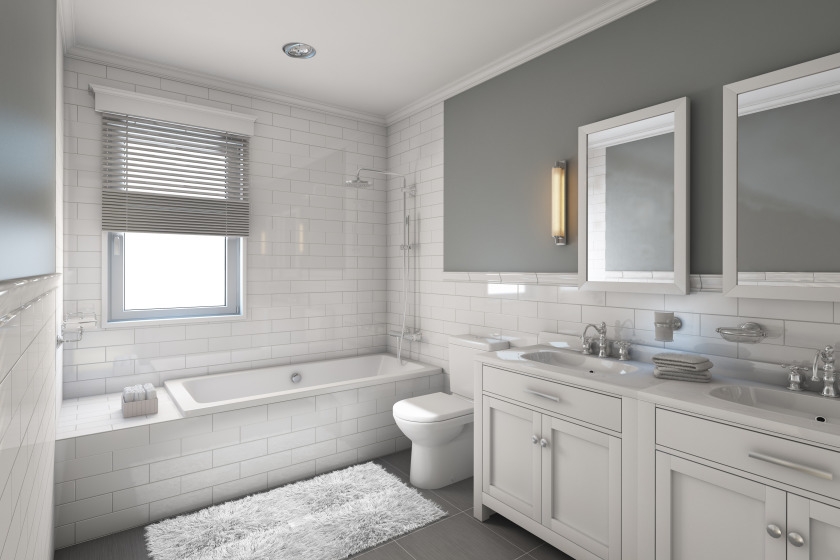If your bathroom is old, outdated or has a clinical feel, turn it into a spa-style retreat. While there are a number of things you can do to create a bathroom getaway, sometimes all it takes is a new color scheme and a fresh coat of paint. It’s like getting a whole new room without spending a lot of money.
Step 1: Choose Colors
Nothing makes a bigger impact on a room than color, especially in a small bathroom where there’s limited space for decorative furnishings and accessories.
The right color can create a feeling of size or warmth and can also help fixtures blend with their surroundings. Choose colors that match or complement other rooms in your home. Light or neutral colors, for example, make things look larger while darker colors have the opposite effect. Warm, sunny shades make rooms seem intimate and inviting. The cool colors of the ocean and sky, on the other hand, create a sense of rest and relaxation.





Complementary rugs, shower curtains, window treatments and towels are inexpensive and may provide color and design interest. Eye-catching wall art and vases reflect your unique personality. If space allows, add a chest, armoire or comfortable chair to make the room more inviting.
Helpful Tip
Replacing old, outdated cabinet hinges, doorknobs and drawer pulls with new ones can instantly give your bathroom a fresh new look.
Step 2: Reduce Clutter
Get rid of unwanted items in the medicine cabinet, on the counter and under the sink. Organize other items in cosmetic bags and/or storage bins or display them in attractive containers on the counter.
Helpful Tip
You have many storage options, including functional and space-saving items such as turntables or pullout boxes, drawers and decorative containers to enhance the room. Make sure you have enough space to accommodate them so they don’t add to the clutter. Store cleaning supplies in portable plastic containers under the sink or on a high shelf.
Step 3: Prepare the Room
Before you begin, remove all towels, bath mats, shower curtains and other bathroom essentials. Once you’ve cleared those away, determine whether any drywall or plaster repairs are required. If so, allow a day or two to make these repairs. Be sure to clean surfaces to be painted with mild detergent and water and allow time to dry. Then mask the areas you won’t be painting — baseboards, windows, doors and electrical outlets — with painter’s tape.
Safety Alerts!
Open the windows or use a fan to make sure you are painting in a well-ventilated area. You don’t want to inhale paint fumes for extended periods of time. Take some breaks after finishing walls so you can stretch — but don’t take a break in the middle of painting a wall.
If you scrape, sand or remove old paint you may release lead dust, which is toxic. Exposure to lead dust can cause serious illness, such as brain damage, especially in children. Pregnant women should also avoid exposure. Wear a NIOSH-approved respirator to control lead exposure. Clean up carefully with a HEPA vacuum and a wet mop. Before you start, find out how to protect yourself by contacting the National Lead Hotline at 1-800-424-LEAD or log on to www.epa.gov/lead.
Step 4: Prime Walls
Unless the existing finish is a flat sheen, you’ll need to apply a primer coat to make the new paint adhere. On flat-painted walls with minor repairs you may simply choose to spot prime. For walls with larger areas of patching plaster, use True Value EasyCare Ultra Premium Interior Primer/Sealer. Priming doesn’t require as much care as painting, but it’s done the same way — with either a brush or roller. Start with the ceiling, first covering the perimeter and unpainted areas around the fixtures.
Helpful Tips
If you’re using latex paint, True Value’s Master Painter polyester or nylon brushes work best. Use natural bristle brushes if you are working with oil-based or alkyd-based paints.
We recommend more durable paint finishes — eggshell, satin, semi-gloss and gloss sheens with mildewcides — for high-moisture rooms.
Step 5: Apply Brushwork
First, mask the perimeter of the ceiling with painter’s tape. Then apply EasyCare Ultra Premium Interior Paint to the upper perimeter of the walls as well as all areas that cannot be covered with the roller. An angled-sash brush works well for cutting in. Get as close to the area as you can and lay on the paint about ¼” away from the edge of the surface. On the second pass, apply more pressure to carefully push the paint into place. Paint the second coat in the same direction you paint the first coat.
Helpful Tips
When using latex paint, “cut in,” or outline an entire room before you start rolling on the paint. When using oil-based paint, only ”cut in” what you can roll over before the cut-in area dries.
When doing the ceiling brushwork it’s easier to have the paint in a smaller can, like a coffee can. That way you don’t have to lug a heavy paint can up the ladder with you.
Step 6: Rolling the Walls and Ceiling
Using your roller, paint in 6′ square sections. Use a series of overlapping “W” strokes from right to left, then back from left to right. Spread the paint evenly using horizontal strokes.
Helpful Tips
Feather the edges of the squares — this means to use less pressure when you get to the edges. This prevents creating a line when the paint overlaps from another square. Keep working with the squares until the surface is complete. Without adding more paint and using light strokes, re-roll from the bottom of the wall to the top (or across the ceiling) to ensure everything is even.
If you’re using any finish other than flat, go over the entire surface (for very large areas do two square sections at a time) once again with one-directional, overlapping, non-diagonal strokes to blend the paint.
Be sure to choose a roller cover that suits the surface texture. Master Painter roller covers by True Value are designed to meet specific needs — like a “popcorn” or textured ceiling. Associates at your local True Value can recommend the right roller cover for your project.
Use the brush to paint wherever the roller doesn’t reach, like in the corners and next to doors, windows and molding. Again, only dip one inch of the bristles into the paint.
Paint the second coat the same way you painted the first coat.
Roll closer edges without making a smeary mess. Put your hand inside a plastic bag then grasp the paint-soaked roller handle cage so it extends about one inch past the end of the roller. This allows you to roll right up to edges and hide any brush strokes.
Step 7: Paint the Trim, Doors and Windows
For base molding run your painter’s tape along the floor. For doors, you need to take off the handles and strike plates. If you have inset panels, paint them first, then the horizontal bars and then the vertical.For windows, paint the top part of the outside sash and the inside sash. Make sure you open and close the window every so often so they don’t stick. Don’t worry about getting paint on the glass. Just wait a day and use a one-sided razor blade to scrape it off.
Step 8: Clean Up
The last step is to clean up. Good brushes will last for many years if you treat them well. Use a brush comb to separate bristles that stick together near the heel of the brush. Rinse the brush in water if you’ve used latex paint, or paint thinner for oil or alkyd-based paint. When the water or paint thinner runs clear, shake out any excess liquid. Put the brush back in its protective sleeve or hang it on a nail or hook. Throw away used roller sleeves and clean up trays. If you used tray liners, just throw them away.
Pick up drop cloths, replace switch and outlet plates and door hardware. Wipe off the lip of the paint can and replace the lid. Save the paint for touch ups.
Helpful Tip
Before you put on the cover plates, put a piece of masking tape on the back. Write down the name of the paint color so you’ll have it whenever you have to do touch-ups.
Safety Alert!
Don’t throw used paint thinner down the drain. Some states don’t even allow it. Find out where and how you can properly dispose of any used paint thinner.
You’re finished! Now step back and admire your new bathroom.
Project Shopping List
Here’s what you’ll need to complete this project successfully.
- Rugs
- Shower curtains
- Window treatments
- Bath towels
- Art (optional)
- Vases (optional)
- Cabinet hardware
- Cosmetic bags
- Storage containers and bins
- Turntables
- Pullout boxes
- Decorative drawers (optional)
- Phosphate-free cleaner
- Sandpaper
- Sanding sponge
- Sponge
- Painter’s tape
- Drop cloths
- Ladder
- NIOSH-approved respirator
- HEPA vacuum (if scraping, sanding or removing old paint)
- Mop
- EasyCare Ultra Premium Interior Paint
- EasyCare Ultra Premium Interior Primer/Sealer
- Master Painter paintbrushes
- Master Painter roller
- Master Painter roller cover
- Master Painter angled-sash brush
- Paint tray
- Fan
- Coffee can or similar container
- Plastic bag
- One-sided razor blade
- Brush comb
- Paint thinner












